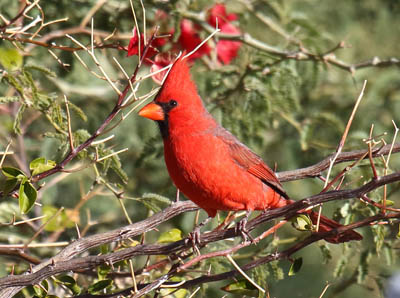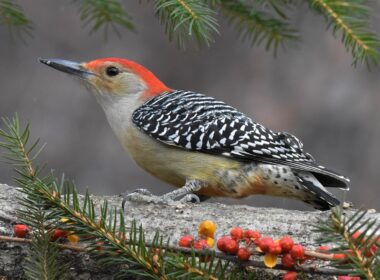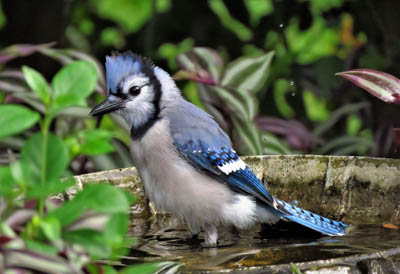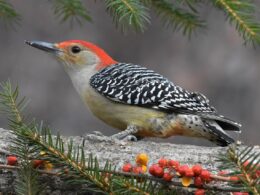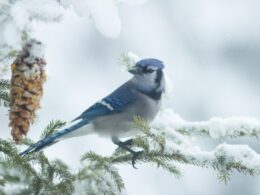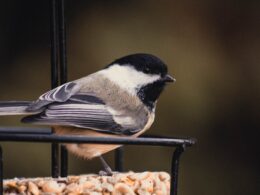Last Updated on January 21, 2024 by Greg Gillson
Cute little chickadees, nuthatches, goldfinches, and juncos are some of the small birds that you may wish to attract to your bird feeders.
But often larger aggressive birds take over the bird feeders.
Jays, starlings, grackles, and even doves can come in and drive the small birds away and eat all the bird food.
How can you set up your bird feeders so that you attract small birds, while discouraging larger birds?
It is all about your bird feeders.
I’ll give you several ideas for attracting small birds to your backyard feeders.
The single best bird feeder to attract small birds is the tube style bird feeder.
Other specialty bird feeders that attract primarily small birds include caged bird feeders, upside-down suet feeders, and Niger seed feeders.
 |
| Black-capped Chickadee on upside-down suet feeder Photo by Greg Gillson |
Why feed only small birds?
Why feed small birds? Don’t you want to feed all the birds that come? There are some good reasons to feed only small birds, or primarily small birds. But mostly, it is just personal preference.
Small birds are active. They often allow close approach. Many are brightly colored. These are such a joy to watch!
Small birds more easily use feeders on your porch or deck. You can hang small bird feeders from the eaves outside your favorite window for observing them.
With their large heads and eyes, they often appear “cute.” People are attracted to “cuteness.” Thus, many people just like the way small birds look.
At your feeder, small birds don’t eat as much as larger birds. This can save you money on bird food. It can also save you some time constantly refilling an empty feeder.
Theoretically, smaller birds may be less messy than larger birds. Of course, that all depends upon how many birds come to your feeders.
Feeders to attract small birds
To attract small birds and discourage larger birds, you must carefully choose your bird feeders and bird food.
Use the weight of large birds against them!
Heavier birds require larger and more sturdy bird feeders. Most don’t have strong legs and feet. So they require a shelf or tray to stand on. They need a perch for their feet that tinier and lighter birds don’t necessarily need.
Use the size of large birds against them!
Little birds can fit into spaces that large birds cannot. This allows you to choose bird feeders that block large birds that still allow small birds to feed.
Small birds with tiny bills eat smaller seeds than large birds. You can choose some seeds that small birds prefer.
There are certain seeds and fillers in bird food that you should avoid because they attract larger birds and the smaller birds won’t eat.
Choose the correct feeder and food to attract small birds and discourage larger birds.
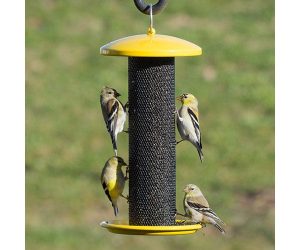
Tube feeders for small birds
Tube-shaped bird feeders are perfect for small birds!
They are narrow and tall. Large birds have great difficulty perching on them and feeding.
[See my article on 7 kinds of bird feeders.]
Make sure to purchase tube feeders without a feeding tray on the bottom if you want to discourage larger birds.
Here is an example of a tube feeder that I would recommend as perfect for small birds. It is the Droll Yankees Classic, 16 inches tall, with 6 feeding ports.
The best food to put in a tube feeder is black oil sunflower seeds. This is the seed most sought after by birds.
[Read my article on the bird seed that attracts the most birds.]
Tube feeders with black oil sunflower seeds are a favorite of chickadees, nuthatches, house finches, and goldfinches.
I like the generally low price of Wagner’s black oil sunflower seed if purchasing online. When you visit a store that carries black oil sunflower seed look out for a good deal of less than $1 per pound. I recently bought a 40 pound bag at a farm/hardware store for about half that!
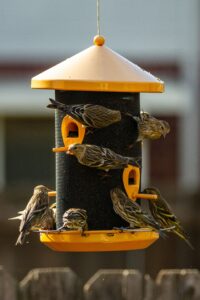
Caged feeders for small birds
Some bird feeders have been designed with a metal cage around them to keep out squirrels.
Guess what? They also keep out large birds!
The cage will keep out squirrels, but also most starlings, blackbirds, jays, and grackles. However, it will likely also keep out grosbeaks and cardinals.
For this feeder I really like Wagner’s Songbird Supreme as the best mixed bird seed for small birds.
It is 50% sunflower seeds, both in the shell and hulled. It also contains white proso millet. But it doesn’t have any filler seed. No red milo. No cracked corn or other seeds that many small birds don’t eat.
The combination of sunflower seeds and white millet in Wagner’s Songbird Supreme will attract goldfinches, house finches, chickadees, nuthatches, juncos, white-crowned sparrows, and others.
[Read my review of the Wagner’s Songbird Supreme and why I like it so much!]
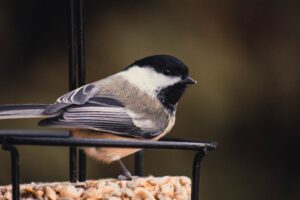
Suet feeders for small birds
The opening photo shows a Black-capped Chickadee on the Nature’s Way Upside-Down Suet Feeder.
Many birds are attracted to suet–especially lager birds like jays and starlings. They can quickly consume a suet block.
Upside-down suet feeders make it harder for larger birds to get at the suet. Smaller birds have no trouble hanging upside-down to feed. Woodpeckers, with their strong legs and feet also feed easily from below.
[Read my article on where best to place a suet feeder.]
Small birds love the upside-down suet feeders. They have less competition from larger birds.
Warblers, wrens, bushtits, and other birds that don’t eat seeds will also come to the suet feeder. Chickadees and nuthatches love suet, too.
I’ve been purchasing St. Albans Bay suet in the mixed pack of berry and peanut. Birds really seem to love it.
Thistle feeders for small birds
My final suggestion for feeding small birds is to attract goldfinches, siskins, redpolls, and house finches with Niger seed.
Larger birds do not eat Niger seed–it is just too small. Even other smaller birds do not eat it.
Niger seed is fed in special bird feeders known as thistle feeders, thistle socks, and finch feeders.
[Read my article: What is a thistle sock? What is a thistle feeder?]
The thistle feeder I like has a tray under it to catch seeds. These small seeds fall out of a feeder easily, so catching the seeds on the tray is a good way to prevent waste of these rather expensive seeds.
This Perky Pet Finch Feeder is perfect for Niger seed. It has a metal screen that birds pull the seed through.
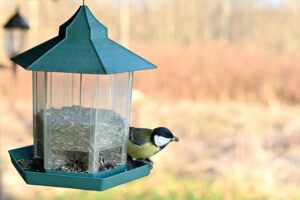
Just remember that these seeds spoil easily when wet. So don’t put too much seed out at a time.
Something else to keep in mind is that Niger seed does not keep over winter very well. Birds won’t eat old Niger seed. So if birds aren’t eating your Niger seed it may need replaced with fresh.
I recommend starting with a smaller quantity of Niger seed.
That’s it, then. If you offer black oil sunflower seeds in a tube feeder, perhaps in a cage, you will attract many small birds to your backyard.
Add an upside-down suet feeder and a thistle feeder, and you’ll have even more brightly-colored and interesting birds!
Wrapping Up
While small birds generally have faster metabolisms and burn energy quicker due to their smaller body size, the question of whether they need feeding more than larger birds is complex and depends on several factors:
Food Availability:
- Natural Food Sources: In environments with abundant natural food sources like insects, fruits, and seeds, all birds, regardless of size, can find sufficient sustenance. However, during harsh winter months or in habitats with depleted resources, smaller birds might struggle more due to higher energy requirements and limitations in accessing certain food sources.
- Competition: In areas with limited food and increased competition, smaller birds might be disadvantaged due to their size and lower dominance compared to larger birds. Feeders can provide a valuable additional source of food for them in such scenarios.
Energy Expenditure:
- Metabolism: Small birds have much faster metabolisms compared to larger birds, meaning they burn energy at a much higher rate to maintain their body temperature. This can make them require more frequent feeding, especially in cold weather or during periods of high activity.
- Activity Levels: Flight is energetically expensive for all birds, but smaller birds expend a higher proportion of their energy per unit body mass compared to larger ones. This can contribute to their increased need for food, especially while migrating or actively foraging.
Frequently Asked Questions
What household food can I feed wild birds?
While the urge to help your feathered friends is admirable, it’s important to be cautious when feeding wild birds household food. Many common kitchen scraps can be harmful or even fatal to them due to digestive issues, nutritional deficiencies, or the potential for attracting pests and diseases.
Here are some household foods you can feed to the birds:
- Unsalted nuts and seeds: Peanuts, pecans, walnuts, sunflower seeds, pumpkin seeds (unseasoned and raw). Avoid almonds and macadamia nuts, which can be toxic.
- Fruits: Fresh or dried fruits like apples, pears, berries, grapes, oranges (cut into small pieces). Avoid avocado, citrus peels, and unripe fruit.
- Cooked grains: Plain cooked rice, pasta, oatmeal (unsweetened and unsalted). Avoid bread and baked goods, which can mold and attract unwanted pests.
- Hard-boiled eggs: A protein source, but offer in moderation and remove shells after.
- Suet: A high-fat food good for winter feeding, but choose commercially prepared suet cakes to avoid attracting predators.
Do birds get bored of the same food?
While birds don’t experience boredom in the same way humans do, they can show some behaviors that suggest a decreased interest in the same food sources over time. Here’s what we know:
Variety Matters:
- Nutritional Needs: Birds require a balanced diet of different nutrients like proteins, carbohydrates, and fats. A consistently monotonous diet could lead to deficiencies, affecting their health and energy levels.
- Foraging Instinct: Bird brains are hardwired for foraging and exploring different food sources. Sticking to the same options might not stimulate their natural instinct and could potentially dampen their enthusiasm for feeding.
Possible Indicators:
- Selective Feeding: Birds might avoid specific parts of the same food, focusing on the elements they prefer or neglecting less desirable components.
- Reduced Feeding Activity: They might visit feeders less frequently or spend less time foraging, suggesting a waning interest in the available food.
- Increased Foraging Efforts: Conversely, they might exhibit more focused searching for alternative food sources in the environment, indicating a desire for something different.
Do birds tell each other where food is?
Whether birds directly tell each other where to find food is a complex question with ongoing research, but there’s certainly evidence suggesting they communicate about resource location in various ways. Here’s a dive into the fascinating world of avian communication and food sharing:
- Calls and Vocalizations: Birds use specific calls to warn each other about predators or dangers, which can indirectly lead them to safer feeding areas. For example, chickadees have different calls for different predators, alerting others to avoid specific locations.
- Flocking Behavior: Many birds, like sparrows and finches, gather in flocks for foraging. Their collective searching increases the chance of finding food sources, and the presence of others can signal a safe and productive area for individual feeding.
- Observational Learning: Watching successful foragers can teach younger birds or inexperienced individuals about profitable food patches. Observing others exploit a resource can be a valuable learning experience, guiding them to similar locations.
Related Articles:
Top 5 ways to get hummingbirds to come to your feeder
From scratch: Setting up your first bird feeder
QUICKLY attract birds to your feeder



